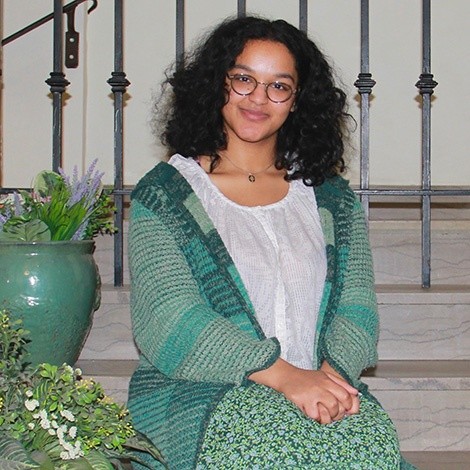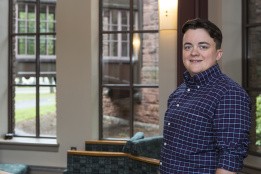A natural way to begin if you have not studied statistics is with STAT-140, Introduction to the Ideas and Applications of Statistics.
A 200-level course in statistics is a good choice if you have taken an advanced placement statistics course or have taken the equivalent of a 100-level statistics course.
Students interested in this area should plan to cover the material that is included in the first two actuarial exams as part of their undergraduate program. This material is included in Calculus I (MATH-101), Calculus II (MATH-102), Calculus III (MATH-203), Probability (MATH-342), and Mathematical Statistics (STAT-343), along with Macroeconomic Theory (ECON-211), Microeconomic Theory (ECON-212), and Economics of Corporate Finance (ECON-215). Students are also encouraged to obtain experience through an internship.
Students interested in these areas should include substantial work in biology, chemistry, geology, and/or environmental studies in their programs.
Students interested in engineering often double-major in mathematics and physics and/or participate in one of the College’s five-year, dual-degree programs with Dartmouth’s Thayer School of Engineering, or California Institute of Technology, or the University of Massachusetts (see the Other Degree and Certificate Programs chapter).
Students preparing for graduate school in statistics or mathematics often participate in an undergraduate research program in the summer after the junior year and continue with an honors thesis in the senior year. Students considering graduate work in statistics at the level of a Ph.D. are encouraged to include abstract algebra and especially MATH-301.
Students interested in pursuing certification for middle school or secondary school should major in mathematics rather than statistics. However, there is increasing emphasis on statistics in secondary school, and any of the applied courses would provide good preparation.
STAT-107 Foundations of Data and Visualization
Pictures, plots, and visualizations can be incredibly effective ways to understand information, tell stories, and make arguments. But how do you know if a picture is telling the truth? How do you make a picture that tells your story? In this course, we'll explore ways to understand, critique, and create different types of data visualizations: things you'll see in the news and generate in your future jobs. We'll also focus on building foundational skills and comfort with data, code, and tools that will prepare you not just for future statistics and data science courses, but also for the ever-growing quantitative component of work in the humanities and social sciences.
STAT-140 Introduction to the Ideas and Applications of Statistics
This course provides an overview of statistical methods, their conceptual underpinnings, and their use in various settings taken from current news, as well as from the physical, biological, and social sciences. Topics will include exploring distributions and relationships, planning for data production, sampling distributions, basic ideas of inference (confidence intervals and hypothesis tests), inference for distributions, and inference for relationships, including chi-square methods for two-way tables and regression.
STAT-242 Intermediate Statistics
In this course, students will learn how to analyze data arising from a broad array of observational and experimental studies. Topics covered will include exploratory graphics, description techniques, the fitting and assessment of statistical models, hypothesis testing, and communication of results. Specific topics may include multiple regression, ANOVA, and non-linear regression. Statistical software will be used.
STAT-244 Intermediate Topics in Statistics
STAT-244MP Intermediate Topics in Statistics: 'Survey Sampling'
In this course, students will explore statistical techniques for designing and analyzing complex survey designs. Sample surveys are used to obtain data on demography, health, and development; to measure attitudes and beliefs; to estimate natural resources; to evaluate the impact of social programs; along with many other uses. The proper design and analysis of these surveys is crucial to their utility. We will cover topics including survey design, estimation, poststratification, imputation, and survey error. We will also apply these methods by frequently using real (and often messy) survey data through assignments and projects. The analysis of the data will be performed through R programming. Background should include estimation, confidence intervals and hypothesis testing.
STAT-244NF Intermediate Topics in Statistics: 'Infectious Disease Modeling'
Infectious disease has plagued humanity since time immemorial. Statistical models serve a critical role in improving understanding of the progression and proliferation of infection in a population, as well as the impact of interventions in stopping the spread of disease. In this course, we will explore regression and compartmental model-based approaches, which will be motivated by some of the most impactful epidemics and pandemics in recent history, including HIV/AIDS, Ebola, Zika, and COVID-19. R statistical software will be used.
STAT-244NP Intermediate Topics in Statistics: 'Nonparametric Statistics'
The methods taught in traditional statistics courses are based on assumptions that are often not satisfied by real data sets. In this course we will learn about approaches that require fewer assumptions, known as nonparametric methods. After taking this course, students will be able to examine assumptions for different approaches to statistical inference, compare nonparametric statistical tests such as sign and Wilcoxon tests to their parametric equivalents, and implement non-parametric approaches using R. In addition, the course will incorporate computational techniques for statistical analysis, including simulation, permutation tests, and bootstrapping.
STAT-244SC Intermediate Topics in Statistics: 'Computational Statistics'
Computation is now an essential component of several modern statistical methods. This course will introduce students to computationally intensive techniques in statistics and explore the role of computation as a tool for discovery. Specifically, it will emphasize simulation-based, rather than calculus-based, approaches in statistical theory. Topics may include sampling algorithms, numerical analysis, and missing data. All data analysis in the course will be performed using R software. Research applications will be emphasized through assignments and student-defined projects.
STAT-295 Independent Study
STAT-331 Design of Experiments
How do you get informative research results? By doing the right experiment in the first place. We'll look at the techniques used to plan experiments that are both efficient and statistically sound, the analysis of the resulting data, and the conclusions we can draw from that analysis. Using a framework of optimal design, we'll examine the theory both of classical designs and of alternatives when those designs aren't appropriate. On the applied side, we'll use R to explore real-world experimental data from science, industry, and everyday life; and we'll discuss key principles for working with expert (and not-so-expert) collaborators to help them set up the experiments they need.
STAT-340 Applied Regression Methods
This course includes methods for choosing, fitting, evaluating, and comparing statistical models; introduces statistical inference; and analyzes data sets taken from research projects in the natural, physical, and social sciences.
STAT-343 Mathematical Statistics
This course is an introduction to the mathematical theory of statistics and to the application of that theory to the real world. Topics include probability, random variables, special distributions, introduction to estimation of parameters, and hypothesis testing.
STAT-344 Seminar in Statistics and Scientific Research
STAT-344ND Seminar in Statistics and Scientific Research: 'Analysis of Neural Data'
Neuroscience addresses big questions about the mind by studying the structure and function of the brain -- questions like: How do we remember, learn, and make decisions? Why do we feel emotions and experience consciousness? What causes mental illness? This increasingly means analyzing datasets that are large, complex, high dimensional, and time varying. Neural data analysis employs a unique set of concepts and approaches drawing on statistics, mathematics, physics, and computer science. In this course, we will apply these techniques to real neural datasets through hands-on activities and a final independent project. Possible topics include statistical modeling of neuronal spiking data; analysis of high-dimensional data with spatial structure (e.g., EEG, fMRI); and techniques in time series analysis (e.g., autoregressive modeling, time-frequency decomposition, network connectivity, causality).
STAT-344TM Seminar in Statistics and Scientific Research: 'Time Series Analysis'
Time series -- data collected across time -- show up in a vast range of application areas, from climate to economics to music. But they can have special behaviors, like seasonality, memory, and directionality, that require some special treatment! We'll look at tools for describing, modeling, and predicting time series behavior. Topics include decomposition, ARIMA, exponential smoothing, dynamic regression, and a foray into the frequency domain. We'll apply these concepts using real datasets in R.
STAT-351 Bayesian Statistics
Bayesian statistics refers to a statistical paradigm that has its roots in Bayes' theorem, where prior belief and data can be combined to update our understanding of a particular problem in what is known as the posterior. In this class, you can expect to combine your knowledge of probability and statistics to develop and apply Bayesian thinking to statistical modeling. Possible topics include conjugate families, posterior simulation, regression and classification, and hierarchical modeling. R statistical software will be used.
STAT-395 Independent Study



